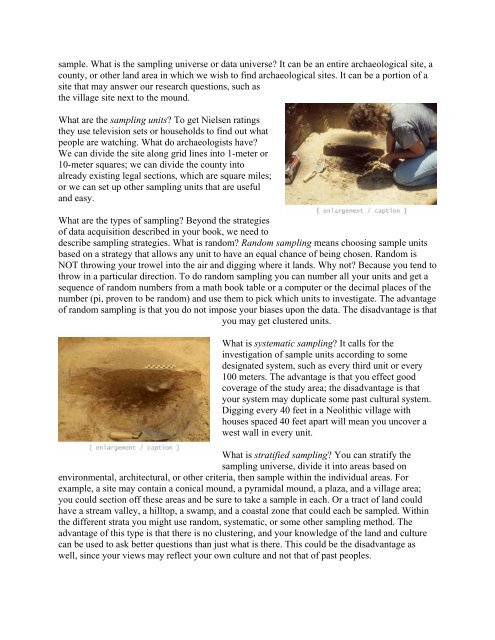INTRODUCTION TO ARCHAEOLOGY Nancy White - Touro Institute
INTRODUCTION TO ARCHAEOLOGY Nancy White - Touro Institute
INTRODUCTION TO ARCHAEOLOGY Nancy White - Touro Institute
You also want an ePaper? Increase the reach of your titles
YUMPU automatically turns print PDFs into web optimized ePapers that Google loves.
sample. What is the sampling universe or data universe? It can be an entire archaeological site, a<br />
county, or other land area in which we wish to find archaeological sites. It can be a portion of a<br />
site that may answer our research questions, such as<br />
the village site next to the mound.<br />
What are the sampling units? To get Nielsen ratings<br />
they use television sets or households to find out what<br />
people are watching. What do archaeologists have?<br />
We can divide the site along grid lines into 1-meter or<br />
10-meter squares; we can divide the county into<br />
already existing legal sections, which are square miles;<br />
or we can set up other sampling units that are useful<br />
and easy.<br />
What are the types of sampling? Beyond the strategies<br />
of data acquisition described in your book, we need to<br />
describe sampling strategies. What is random? Random sampling means choosing sample units<br />
based on a strategy that allows any unit to have an equal chance of being chosen. Random is<br />
NOT throwing your trowel into the air and digging where it lands. Why not? Because you tend to<br />
throw in a particular direction. To do random sampling you can number all your units and get a<br />
sequence of random numbers from a math book table or a computer or the decimal places of the<br />
number (pi, proven to be random) and use them to pick which units to investigate. The advantage<br />
of random sampling is that you do not impose your biases upon the data. The disadvantage is that<br />
you may get clustered units.<br />
What is systematic sampling? It calls for the<br />
investigation of sample units according to some<br />
designated system, such as every third unit or every<br />
100 meters. The advantage is that you effect good<br />
coverage of the study area; the disadvantage is that<br />
your system may duplicate some past cultural system.<br />
Digging every 40 feet in a Neolithic village with<br />
houses spaced 40 feet apart will mean you uncover a<br />
west wall in every unit.<br />
What is stratified sampling? You can stratify the<br />
sampling universe, divide it into areas based on<br />
environmental, architectural, or other criteria, then sample within the individual areas. For<br />
example, a site may contain a conical mound, a pyramidal mound, a plaza, and a village area;<br />
you could section off these areas and be sure to take a sample in each. Or a tract of land could<br />
have a stream valley, a hilltop, a swamp, and a coastal zone that could each be sampled. Within<br />
the different strata you might use random, systematic, or some other sampling method. The<br />
advantage of this type is that there is no clustering, and your knowledge of the land and culture<br />
can be used to ask better questions than just what is there. This could be the disadvantage as<br />
well, since your views may reflect your own culture and not that of past peoples.
















